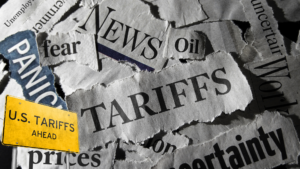🤝 2025 Trade Talks: Are Global Tariff Negotiations Reaching a Breaking Point?
In 2025, free trade is undergoing a rethinking, and perhaps deconstruction, of its promise. The foundations of globalization are crumbling as a result of post-pandemic protectionism, economic nationalism, and geopolitical animosity. Global trade regulations are being reshaped by individual countries to align with their local agendas, as bilateral tensions escalate and the World Trade Organization (WTO) takes a back seat. A big topic is whether or not multilateral commerce is slowly dying.
🌐 WTO: From Global Mediator to Global Stalemate
The World Trade Organization, once seen as the arbiter of international trade, is struggling to remain relevant in a world increasingly driven by national interests.
At the latest WTO summit in Geneva, negotiations collapsed over:
- Agricultural subsidies between the EU and the U.S.
- Technology transfer rules, with China pushing back against Western attempts to regulate AI exports
- Tariff ceilings, as Global South countries demand more flexibility in protecting emerging industries
This gridlock isn’t new—but it’s more intense than ever. With the dispute settlement mechanism still paralyzed due to U.S. opposition to appellate judge appointments, enforcement of trade rules is practically toothless.
Global trade experts are asking: If the WTO can’t mediate or enforce, is it still the global trade referee?
🇺🇸🇨🇳 Bilateral Tensions: The U.S.–China Standoff Heats Up
The most high-stakes trade battle remains between the United States and China. After a brief easing in early 2024, relations have again soured following:
- New U.S. tariffs on Chinese EVs, semiconductors, and solar panels
- China’s retaliatory restrictions on rare earth mineral exports
- U.S. efforts to create a “chip alliance” with Japan, South Korea, and the Netherlands, aimed at isolating China from advanced semiconductor manufacturing
These moves reflect a broader shift: the U.S. is no longer seeking just fair trade—it’s seeking strategic decoupling, especially in critical industries. In response, China is doubling down on its self-reliance doctrine, prioritizing domestic innovation and regional trade blocs like RCEP.
🇪🇺 Europe’s Dilemma: Between America and Autonomy
The European Union, traditionally a champion of free trade, finds itself torn between aligning with U.S. sanctions and defending its own economic interests.
Key points of tension include:
- Carbon Border Adjustment Mechanism (CBAM): The EU’s new carbon tariff on imports is drawing criticism from developing nations and trade partners.
- Digital trade rules: Brussels is pushing for stricter regulation of cross-border data flows, causing friction with both Washington and Beijing.
- Ongoing agricultural disputes with the U.S. over hormone-treated meat and GMOs
Europe is now exploring deeper trade ties with India, Africa, and Latin America, hoping to reduce reliance on both Washington and Beijing. However, internal divisions within the bloc are making unified trade policy harder to achieve.
🔄 The New Face of “Free Trade”
The concept of free trade in 2025 looks very different from a decade ago. Instead of sweeping global deals, we’re seeing:
- Mini-lateralism: Smaller regional or issue-specific pacts, such as the Indo-Pacific Economic Framework (IPEF) or the Africa Continental Free Trade Area (AfCFTA)
- Friendshoring: Nations shifting supply chains to political allies, not just the cheapest source
- Geoeconomic leverage: Trade is increasingly being weaponized for strategic goals—such as denying technology, limiting access to rare resources, or controlling energy routes
Trade is no longer just about economics—it’s about security, influence, and resilience.
🧩 What’s at Stake?
This shift has major implications:
- Global inflation: Tariffs and fragmented supply chains raise production and shipping costs
- Slower growth: Emerging markets, once lifted by global trade, now face more protectionist barriers
- Less predictability: Businesses face greater uncertainty in planning long-term investments
Most crucially, without a strong WTO or new multilateral mechanisms, conflict resolution will become more politicized, increasing the risk of trade wars spilling into broader geopolitical crises.
🛑 Conclusion: At the Edge of a Trade Reboot
As we move deeper into 2025, the global trade system stands at a crossroads. Will the world double down on strategic competition and fragmented deals? Or will a new vision for cooperative trade emerge—one that balances national security with global prosperity?
One thing is certain: the era of one-size-fits-all free trade is over. What replaces it could either reinvigorate global cooperation—or accelerate economic fragmentation.








